When you think of deer, do you think of a doe feeding in a wilderness meadow, the Disney movie Bambi, or of the light up decorations that were on display over Christmastime in front yards across Canada? For many people, deer are just that—something far away, a cartoon, or merely an inanimate decoration. However, in some cities in British Columbia, deer are a common, yet divisive, part of the urban landscape.
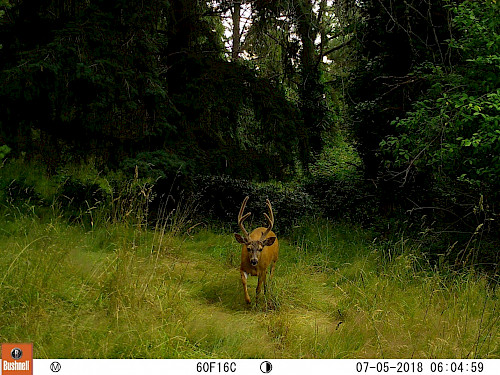
A Columbia black-tailed deer buck.
The native Columbia black-tailed deer (CBTD; a more docile sub-species of the mule deer found on the mainland), has coexisted on the landscape with humans for millennia. The First Nations of southern Vancouver Island used fire for land management that promoted the growth of important food plants like camas and would attract game species like CBTD. However, in the years since European colonization, southern Vancouver Island has grown into 13 municipal districts with a population of over 400,000 people. With the ensuing urban development, suburban sprawl, fire suppression, and predator exclusion has combined to change ecosystem dynamics and species distributions.
Coexistence with humans has resulted in habitat fragmentation, with a whopping 1,807 species at risk of extinction in BC, and over 110 of those species in southern Vancouver Island alone. However, some species do well coexisting with humans, like racoons and deer—which can interact with humans and their property often enough to be considered nuisances. But are these now urban wildlife too numerous and running amok amidst the city backdrop, or is this actually bad press?
Just where are the deer?
The District of Oak Bay has been in the news often about a deer overpopulation problem. They’ve attempted a cull to manage deer populations, but as found in other municipalities, the cull had no lasting impact on the deer population but it did garner a public outcry. Management of the urban deer population has been highly polarizing—some people want them to stay, some people want them completely gone—but the management of urban wildlife is predicated on the knowledge of population size.
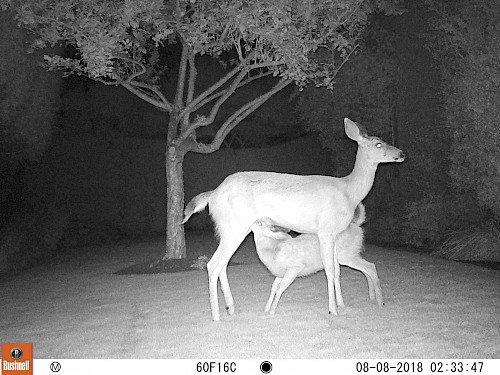
Even deer need to do 2:30 am feedings.
Residents can give wildly different estimates of the number of deer present in Oak Bay. Any single human observer may see six deer in their yard one day and then none the next—humans have a cognitive bias, the availability bias, whereby we note large groups without noting all the absences in between—which inflates estimates. And, when trying to count mobile species, you need to be sure that you’re not counting the same individuals more than once. And if you don’t see a deer, can you be sure that it’s actually not there as opposed to just hiding? Thankfully camera traps to the rescue!
Camera traps
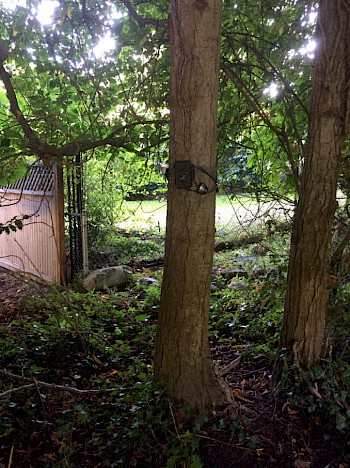
Remote camera trap set up.
We divided the 10.5 km2 of Oak Bay into 400m grid cells, and we systematically placed one camera trap into each of those 39 grid cells. Each camera trap was a Bushnell infra-red remote digital camera, secured to a tree between 0.5-1.5m above the ground. Human observers can miss deer that are well hidden or might miss them in time (e.g. once the observer goes home for the day). The motion activated camera traps are able to take photos throughout the day, eliminating those kinds of errors. The systematic design we used also allows us to differentiate between areas with high numbers of deer and those without deer—and ensured we could collect multiple observations of the same individuals across space—allowing us to get a good idea of space use. In addition to the cameras, we put GPS collars on 20 does to get an idea of home range size in Oak Bay, but the GPS collars had double-duty, to “mark” our known deer population. By measuring how frequently we detected marked (collared) animals at a camera station, compared to the number of unmarked animals, we could get an accurate estimate of population size.
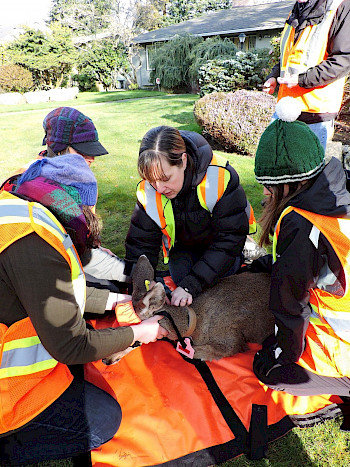
Attaching the GPS collar, which “marks” our deer on our camera trap photos. Each doe has a unique colour combination of tags that identifies each individual.
Combining this systematic camera trap design with GPS collars has allowed us to generate the first, precise and robust estimate of CBTD population size in Oak Bay’s history. So then, just how many deer are running rampant around Oak Bay? Our analyses tell us that there are just under 100 deer (97 is the median, 95% confidence intervals between 72-128), and that they aren’t distributed equally across the municipality. Most deer spent their time within a 0.14km2 area, and the largest average area a deer would use is 0.64km2—significantly smaller than the home ranges they would use in wild environments (~140 to 1,770 ha.) That tells us that Oak Bay residents are seeing the same deer over and over, rather than seeing hoards of deer just once as they migrate through a large area.
Coexistence?
With a definitive understanding of how many deer actually reside within Oak Bay, and where they are concentrating within the municipality, management can now be tailored to be cost effective and successful. This fall, we administered immunocontraceptive (IC) to 60 does, and in the spring of 2020 our camera traps will be able to tell us if this birth control method was successful. If only our control group of does have fawns at the heel on camera trap photos, then we should be able to conclude that IC can be effectively administered as a non-lethal urban wildlife management technique—for Oak Bay, the Capital Region District of Vancouver Island, and other municipalities across BC that are struggling with their own urban deer management. We’ll be looking forward to seeing what the spring 2020 camera trap photos will reveal!
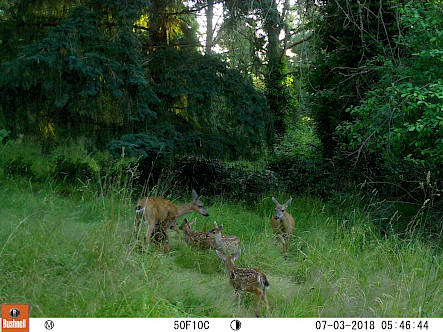
Two does with their twin fawns in 2018. If future camera trap photos of does with fawns are limited to our control group that didn’t get IC, then we should be able to show that it is an effective method of urban deer population control.
About the Author
Alina Fisher is a PhD student in Environmental Biology at the University of Victoria, and a research team member on the Oak Bay deer project. Her research in ecology have included invasive species and endangered species recovery, and how wildlife communities are responding to changing landscapes and climate. She is also a science communication scholar, looking at the impact of social media on conservation attitudes and political agenda setting. Alina lives in Victoria, loves hiking, catching snakes with her daughters, and inspiring grade school children in wildlife conservation.